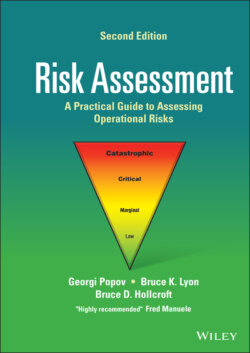Читать книгу Risk Assessment - Georgi Popov - Страница 66
3.12 Risk Treatment
ОглавлениеRisk treatment is the process of modifying risk. As mentioned previously, risks that are judged unacceptable to an organization must be “treated” to reduce risk through the use of risk controls. Risk treatment generally involves the selection and implementation of one or more risk‐control measures or enhancements to existing controls. The risk treatment process involves: (i) the assessment of a risk treatment; (ii) determining if residual risk levels are tolerable; (iii) selecting new risk treatments for those residual risks that are not acceptable; (iv) and assessing the effectiveness of any new control measure. Selection of control options should be made using the Hierarchy of Controls model. Figure 3.6 illustrates the Hierarchy of Controls model reprinted with permission from ANSI/ASSP Z590.3.
Figure 3.6 Risk reduction hierarchy of controls.
Source: Reprinted with permission from ANSI/ASSP Z590.3‐2011(R2016). Courtesy of the American Society of Safety Engineers.
As indicated in ANSI/ASSP/ISO 31000, risk treatment options are not always mutually exclusive or appropriate for all situations. Treatment options include: (i) avoiding the risk by deciding not to start or continue with the activity that gives rise to the risk; (ii) removing the risk source; (iii) changing the likelihood; (iv) changing the consequences; (v) sharing the risk with another party such as insurance contracts and risk financing; and (vi) retaining the risk by informed decision.
